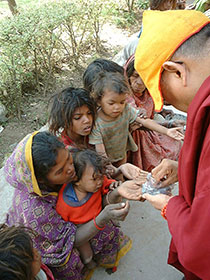- Home
- FPMT Homepage
Foundation for the Preservation of the Mahayana Tradition
The FPMT is an organization devoted to preserving and spreading Mahayana Buddhism worldwide by creating opportunities to listen, reflect, meditate, practice and actualize the unmistaken teachings of the Buddha and based on that experience spreading the Dharma to sentient beings. We provide integrated education through which people’s minds and hearts can be transformed into their highest potential for the benefit of others, inspired by an attitude of universal responsibility and service. We are committed to creating harmonious environments and helping all beings develop their full potential of infinite wisdom and compassion. Our organization is based on the Buddhist tradition of Lama Tsongkhapa of Tibet as taught to us by our founders Lama Thubten Yeshe and Lama Thubten Zopa Rinpoche.
- Willkommen
Die Stiftung zur Erhaltung der Mahayana Tradition (FPMT) ist eine Organisation, die sich weltweit für die Erhaltung und Verbreitung des Mahayana-Buddhismus einsetzt, indem sie Möglichkeiten schafft, den makellosen Lehren des Buddha zuzuhören, über sie zur reflektieren und zu meditieren und auf der Grundlage dieser Erfahrung das Dharma unter den Lebewesen zu verbreiten.
Wir bieten integrierte Schulungswege an, durch denen der Geist und das Herz der Menschen in ihr höchstes Potential verwandelt werden zum Wohl der anderen – inspiriert durch eine Haltung der universellen Verantwortung und dem Wunsch zu dienen. Wir haben uns verpflichtet, harmonische Umgebungen zu schaffen und allen Wesen zu helfen, ihr volles Potenzial unendlicher Weisheit und grenzenlosen Mitgefühls zu verwirklichen.
Unsere Organisation basiert auf der buddhistischen Tradition von Lama Tsongkhapa von Tibet, so wie sie uns von unseren Gründern Lama Thubten Yeshe und Lama Thubten Zopa Rinpoche gelehrt wird.
- Bienvenidos
La Fundación para la preservación de la tradición Mahayana (FPMT) es una organización que se dedica a preservar y difundir el budismo Mahayana en todo el mundo, creando oportunidades para escuchar, reflexionar, meditar, practicar y actualizar las enseñanzas inconfundibles de Buda y en base a esa experiencia difundir el Dharma a los seres.
Proporcionamos una educación integrada a través de la cual las mentes y los corazones de las personas se pueden transformar en su mayor potencial para el beneficio de los demás, inspirados por una actitud de responsabilidad y servicio universales. Estamos comprometidos a crear ambientes armoniosos y ayudar a todos los seres a desarrollar todo su potencial de infinita sabiduría y compasión.
Nuestra organización se basa en la tradición budista de Lama Tsongkhapa del Tíbet como nos lo enseñaron nuestros fundadores Lama Thubten Yeshe y Lama Zopa Rinpoche.
A continuación puede ver una lista de los centros y sus páginas web en su lengua preferida.
- Bienvenue
L’organisation de la FPMT a pour vocation la préservation et la diffusion du bouddhisme du mahayana dans le monde entier. Elle offre l’opportunité d’écouter, de réfléchir, de méditer, de pratiquer et de réaliser les enseignements excellents du Bouddha, pour ensuite transmettre le Dharma à tous les êtres. Nous proposons une formation intégrée grâce à laquelle le cœur et l’esprit de chacun peuvent accomplir leur potentiel le plus élevé pour le bien d’autrui, inspirés par le sens du service et une responsabilité universelle. Nous nous engageons à créer un environnement harmonieux et à aider tous les êtres à épanouir leur potentiel illimité de compassion et de sagesse. Notre organisation s’appuie sur la tradition guéloukpa de Lama Tsongkhapa du Tibet, telle qu’elle a été enseignée par nos fondateurs Lama Thoubtèn Yéshé et Lama Zopa Rinpoché.
Visitez le site de notre Editions Mahayana pour les traductions, conseils et nouvelles du Bureau international en français.
Voici une liste de centres et de leurs sites dans votre langue préférée
- Benvenuto
L’FPMT è un organizzazione il cui scopo è preservare e diffondere il Buddhismo Mahayana nel mondo, creando occasioni di ascolto, riflessione, meditazione e pratica dei perfetti insegnamenti del Buddha, al fine di attualizzare e diffondere il Dharma fra tutti gli esseri senzienti.
Offriamo un’educazione integrata, che può trasformare la mente e i cuori delle persone nel loro massimo potenziale, per il beneficio di tutti gli esseri, ispirati da un’attitudine di responsabilità universale e di servizio.
Il nostro obiettivo è quello di creare contesti armoniosi e aiutare tutti gli esseri a sviluppare in modo completo le proprie potenzialità di infinita saggezza e compassione.
La nostra organizzazione si basa sulla tradizione buddhista di Lama Tsongkhapa del Tibet, così come ci è stata insegnata dai nostri fondatori Lama Thubten Yeshe e Lama Zopa Rinpoche.
Di seguito potete trovare un elenco dei centri e dei loro siti nella lingua da voi prescelta.
- 欢迎 / 歡迎
简体中文
“护持大乘法脉基金会”( 英文简称:FPMT。全名:Foundation for the Preservation of the Mahayana Tradition) 是一个致力于护持和弘扬大乘佛法的国际佛教组织。我们提供听闻,思维,禅修,修行和实证佛陀无误教法的机会,以便让一切众生都能够享受佛法的指引和滋润。
我们全力创造和谐融洽的环境, 为人们提供解行并重的完整佛法教育,以便启发内在的环宇悲心及责任心,并开发内心所蕴藏的巨大潜能 — 无限的智慧与悲心 — 以便利益和服务一切有情。
FPMT的创办人是图腾耶喜喇嘛和喇嘛梭巴仁波切。我们所修习的是由两位上师所教导的,西藏喀巴大师的佛法传承。
繁體中文
護持大乘法脈基金會”( 英文簡稱:FPMT。全名:Found
ation for the Preservation of the Mahayana Tradition ) 是一個致力於護持和弘揚大乘佛法的國際佛教組織。我們提供聽聞, 思維,禪修,修行和實證佛陀無誤教法的機會,以便讓一切眾生都能 夠享受佛法的指引和滋潤。 我們全力創造和諧融洽的環境,
為人們提供解行並重的完整佛法教育,以便啟發內在的環宇悲心及責 任心,並開發內心所蘊藏的巨大潛能 — 無限的智慧與悲心 – – 以便利益和服務一切有情。 FPMT的創辦人是圖騰耶喜喇嘛和喇嘛梭巴仁波切。
我們所修習的是由兩位上師所教導的,西藏喀巴大師的佛法傳承。 察看道场信息:
- FPMT Homepage
- News/Media
-
- Study & Practice
-
-
- About FPMT Education Services
- Latest News
- Programs
- New to Buddhism?
- Buddhist Mind Science: Activating Your Potential
- Heart Advice for Death and Dying
- Discovering Buddhism
- Living in the Path
- Exploring Buddhism
- FPMT Basic Program
- FPMT Masters Program
- FPMT In-Depth Meditation Training
- Maitripa College
- Lotsawa Rinchen Zangpo Translator Program
- Universal Education for Compassion & Wisdom
- Online Learning Center
-
- Prayers & Practice Materials
- Overview of Prayers & Practices
- Full Catalogue of Prayers & Practice Materials
- Explore Popular Topics
- Benefiting Animals
- Chenrezig Resources
- Death & Dying Resources
- Lama Chopa (Guru Puja)
- Lama Zopa Rinpoche: Compendium of Precious Instructions
- Lama Zopa Rinpoche: Life Practice Advice
- Lama Zopa Rinpoche Practice Series
- Lamrim Resources
- Mantras
- Prayer Book Updates
- Purification Practices
- Sutras
- Thought Transformation (Lojong)
- Audio Materials
- Dharma Dates - Tibetan Calendar
- Translation Services
- Publishing Services
- Ways to Offer Support
- Prayers & Practice Materials
-
- Teachings and Advice
- Find Teachings and Advice
- Lama Zopa Rinpoche Advice Page
- Lama Zopa Rinpoche: Compendium of Precious Instructions
- Lama Zopa Rinpoche Video Teachings
- ༧སྐྱབས་རྗེ་བཟོད་པ་རིན་པོ་ཆེ་མཆོག་ནས་སྩལ་བའི་བཀའ་སློབ་བརྙན་འཕྲིན།
- Podcasts
- Lama Yeshe Wisdom Archive
- Buddhism FAQ
- Dharma for Young People
- Resources on Holy Objects
- Teachings and Advice
-
-
*If a menu item has a submenu clicking once will expand the menu clicking twice will open the page.
-
-
- Centers
-
- Teachers
-
- Projects
-
-
-
-
*If a menu item has a submenu clicking once will expand the menu clicking twice will open the page.
-
-
- FPMT
-
- Shop
-
-
-
The Foundation Store is FPMT’s online shop and features a vast selection of Buddhist study and practice materials written or recommended by our lineage gurus. These items include homestudy programs, prayers and practices in PDF or eBook format, materials for children, and other resources to support practitioners.
Items displayed in the shop are made available for Dharma practice and educational purposes, and never for the purpose of profiting from their sale. Please read FPMT Foundation Store Policy Regarding Dharma Items for more information.
-
-
19
Maratika: Where All of Your Prayers Are Fulfilled

Lama Zopa Rinpoche standing on the ridge where the very large Padmasambhava statue will be built above the Maratika Caves, Nepal, September 2021. Photo by Ven. Lobsang Sherab.
By Ven. Sarah Thresher
Maratika, known locally as Halesi, is a sacred pilgrimage site with ancient meditation caves located in eastern Nepal where Guru Rinpoche achieved immortality. Ven. Sarah Thresher has undertaken the journey to Maratika annually since 2007 to make offerings and prayers for Lama Zopa Rinpoche’s long life, and shares here some of the history and features of this holy place, along with some details of Rinpoche’s recent visit and vast vision for its future.
According to the late head of the Nyingma school of Tibetan Buddhism, Dilgo Khyentse Rinpoche, Maratika is one of the six holiest places in this world, along with Bodhgaya in India, Manjushri’s Five-Peak Mountain and the Potala Mountain in China. The remaining two places have not been “opened” yet: Uddiyana and Shambhala. Some years ago, Lama Zopa Rinpoche wrote, “In the Maratika cave where Guru Rinpoche found immortal realization, all your prayers can succeed.”
Ancient scriptures record that long ago Maratika was blessed by the three Buddhas—Manjushri, Chenrezig, and Vajrapani—and that due to this blessing any practice performed on the three hills in Maratika that bear their names is a hundred times more powerful than practices done at other places. It is also said that Eighteen Long Life Tantras—along with other teachings taught by Buddha Amitabha in Sukhavati at the request of Chenrezig—were scribed by dakinis in symbolic script using pure gold and concealed in a jeweled casket in the caves of this holy place. This makes Maratika a particularly powerful place for any kind of practice and especially for those that dispel obstacles to life.
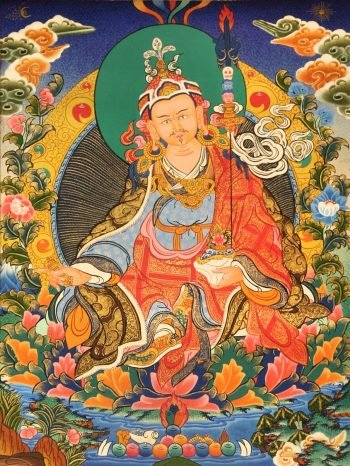
Padmasambhava (also known as Guru Rinpoche)
Since ancient times, generations of great Buddhist masters and practitioners have undertaken the sacred journey to Maratika to practice in its caves. Most famously, the legendary master himself, the second Buddha, Padmasmbhava (known also as Guru Rinpoche), sought the blessings of these caves for his practice of longevity with the Princess Mandarava. After engaging in long-life practice for three months, Buddha Amitayus appeared in front of the Guru and wisdom mother and placed a vase of long-life nectar on their crowns to grant empowerments. Upon drinking the nectar they accomplished the state of immortal life, free from birth and death, and then arose as Hayagriva and Vajravarahi.
The more one reads and learns about Maratika, the more devotion and faith arise that this is not an ordinary place. High lamas have composed praises of Maratika’s outer, inner, and secret qualities. His Holiness Trulshik Rinpoche writes that all twenty-four holy places are contained within Maratika:
Nowhere in India, Tibet, or elsewhere will such an exceptional pilgrimage place be found.
I, an ordinary being, could never finish expressing the qualities of Maratika
But since they are seen to be true, they cannot be denied.[1]
Maratika has long been a popular destination for pilgrims from all over the Himalayan regions—including high lamas from all traditions—but now more and more pilgrims are visiting from around the world. Many come to do long-life prayers and practice for their teachers or themselves.
The previous Trulshik Rinpoche would spend one month of his precious time each year in retreat at Maratika for His Holiness the Dalai Lama’s long life and would send nuns from his gompa at Thubten Choling to stay all year round in continuous long-life practice for His Holiness in the main cave.
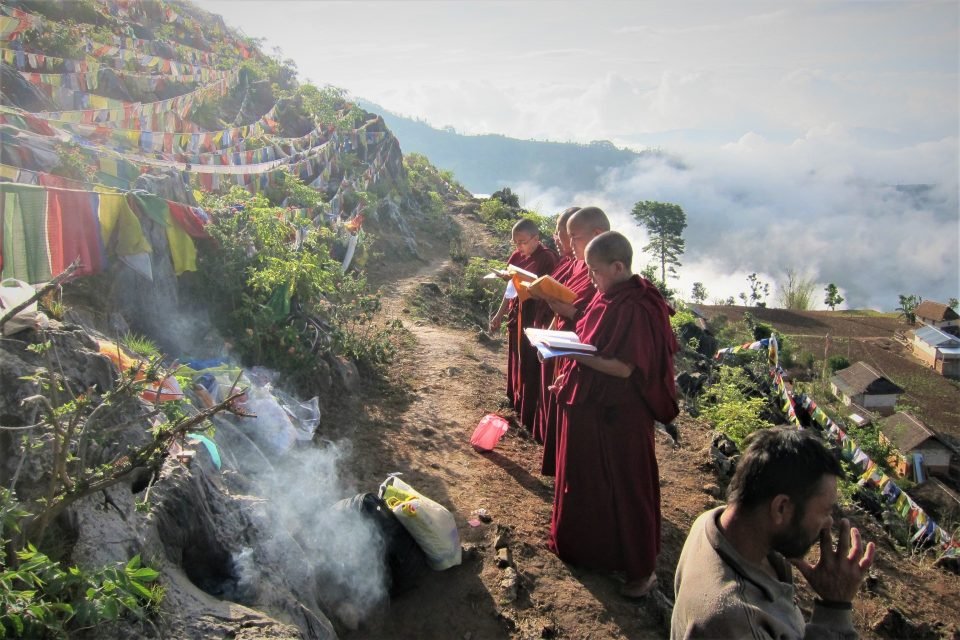
Kopan nuns doing puja on Manjushri Hill in 2013. Photo courtesy of Ven. Sarah Thresher.
For many years, Rangjung Neljorma Khadro Namsel Drönme (Khadro-la) has also come annually to Maratika to do long-life retreat for His Holiness. She usually does retreat in the Guru Rinpoche Secret Save at Manjushri—a smaller cave located near the main cave of longevity—where His Holiness Sakya Trizin and His Holiness Drukchen Rinpoche spent time in retreat. On one occasion Khadro-la had a vision of Buddha Amitayus in this cave that lasted many days, and she made long-life pills, which she later offered to His Holiness.
Anyone can go to Maratika for a short or long retreat or simply for pilgrimage, and it’s still possible to practice in the caves. In the past Khadro-la has recommended that pilgrims stay for three days, three weeks, or three months. It is said that merely having the thought to go to Maratika is very powerful, and His Holiness Sakya Trizin said that on arriving in Maratika all of one’s life obstacles will be removed.
Maratika is situated on a ridge with distant views of the Himalayas to one side and river valleys and hills to the other. The journey to get there, through river valleys and rural Nepal, takes around eight hours by jeep from Kathmandu, so it is necessary to spend at least one or two nights there. Personally, I recommend at least a three-day, four-night stay as there is so much to see, and it’s important to have time for meditation and prayers also.
There are five main caves—the Long-life Cave, the Heruka Cave, the Secret Cave, the Garuda Cave, and the Naga Cave. There is also Mandarava’s Cave, which is in the jungle a half-day’s jeep trip away. Each cave has its own special character: some are very large and others are small, some are high up and others are deeper in the earth.
Both inside the caves and outside on the hills, there are many naturally arising rang jung, or special features—such as a natural conch in the Wrathful Cave, victory banners, umbrellas and pennants hanging from the roof of the caves, dakini script on the walls, a phurba, a treasure chest, a mandala, and so many more.
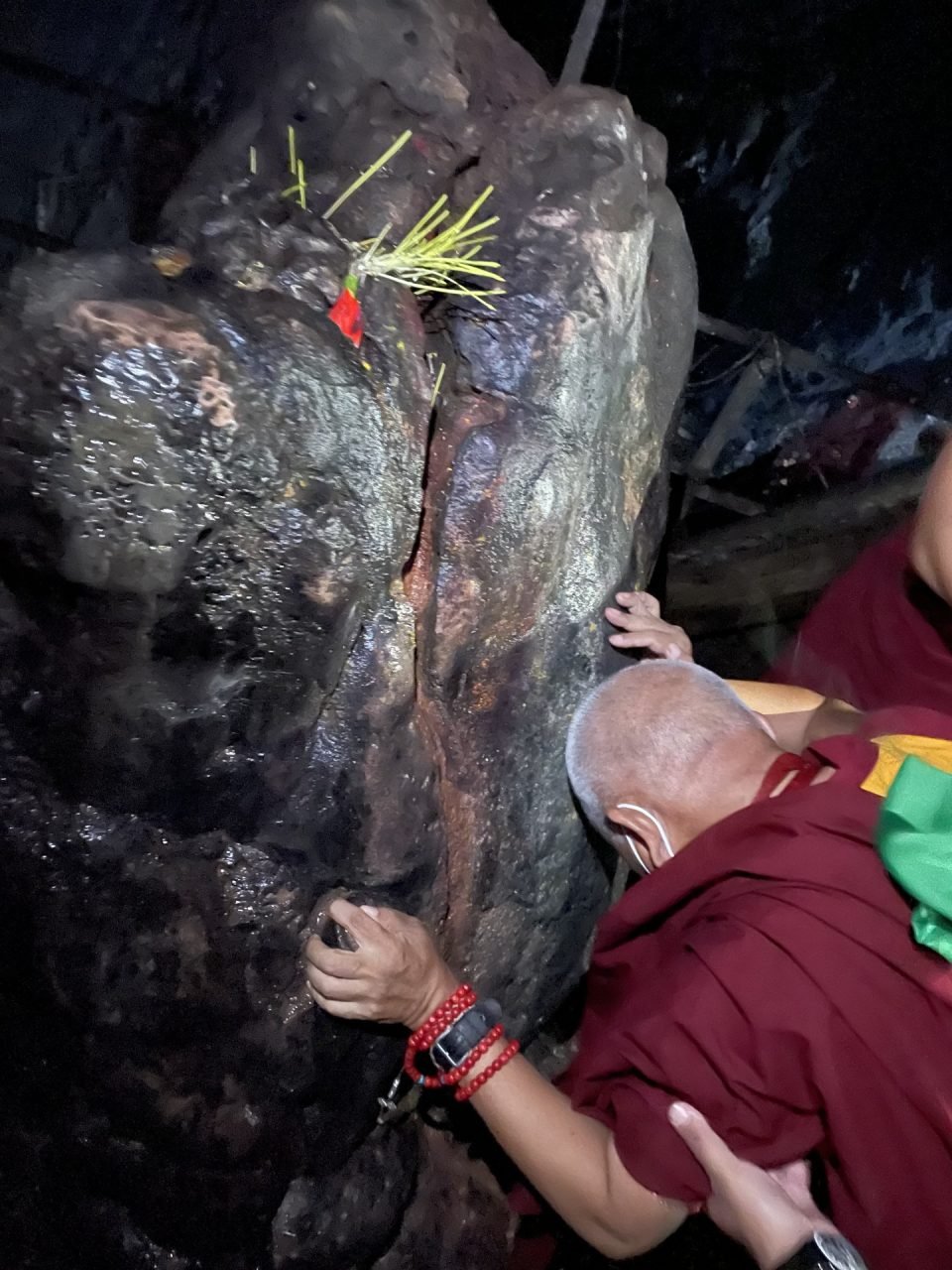
Lama Zopa Rinpoche praying at the Tsebum long life vase where all prayers are fulfilled. Photo by Ven. Sarah Thresher.
One small area of the main cave has many of these kinds of holy objects—the imprint of the holy body of Buddha Amitayus, the Buddha of Long Life; a naturally arising long-life arrow; a White Tara in the rock above; and next to that, Buddha Amitayus’ long-life vase (tse bum), where special nectar will sometimes flow on auspicious occasions. Many meditators like to practice here as these sacred objects make it the perfect place to recite long-life mantras or sutras. The long-life vase is considered the most holy object at Maratika, and it is said that any prayers made at the vase will definitely be fulfilled.[2] There are also four “pathways” inside the main cave—challenges in the rocks that a pilgrim must past through in order to purify the following: birth in the lower realms, the intermediate state, birth from an ordinary womb, and broken samaya with the guru.
There is a connection between FPMT and Maratika. The Lawudo Lama, Kunzang Yeshe, who is Lama Zopa Rinpoche’s previous incarnation, spent time at the pilgrimage site. His heart disciple, Ngawang Chophel, built the monastery at the mouth of the cave and became the first Maratika Lama.[3] On Lama Zopa Rinpoche’s first visit to Maratika in 2008, the young reincarnation of Ngawang Chophel (who passed away in 1997) was there to greet Rinpoche, and they have met since. (He is currently a teenager studying at Mindroling Monastery in India.) Rinpoche has been very generously supporting the small Nyingma monastery at Maratika for many years now. The most recent donations offered were to complete the new monastery building, which is currently underway.
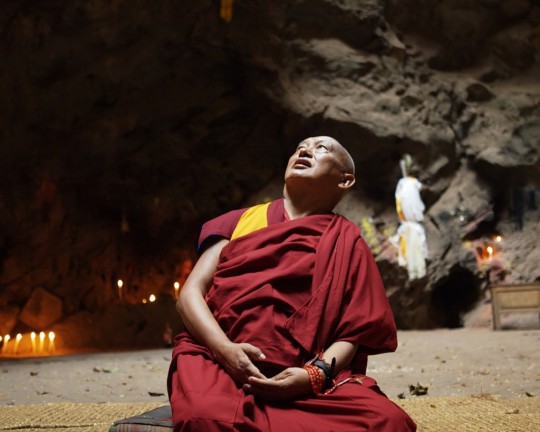
Lama Zopa Rinpoche at Maratika Caves, Nepal, February 2016. Photo by Ven. Losang Sherab.
Over the past fourteen years, the small hamlet that was Maratika has developed rapidly due to the completion of a road from Kathmandu. The cost of land has skyrocketed, and it has become harder and harder to find and purchase suitable property. Like many places that expand quickly, Maratika’s growth has been somewhat chaotic and unplanned. Hotels and guesthouses have sprung up all over what used to be an idyllic landscape of fields. Whereas in the past it was necessary to trek several days to reach the caves and stay in conditions of hardship, it is now a relatively easy journey with quite luxurious new hotels in which to stay.
There is no doubt that Maratika will continue to develop, bringing with it a constant influx of many thousands of pilgrims, similar to Bodhgaya. Most of these pilgrims will not be Buddhist and with this growth, there is the danger that some of the pilgrimage site’s rich Buddhist heritage could be lost.
With this in mind, Rinpoche has envisioned the construction of a huge Padmasambhava statue on Manjushri Hill above the Guru’s Secret Cave. People will be able to visit the statue and practice there. A plot of public land has been secured, plans have been drawn up, and the construction team and statue maker have been appointed.
The statue of Padmasambhava, which is planned to be 45 feet (14 meters) tall with a 15-foot (4.5-meter) throne, will be in the aspect of Padma Gyalpo, Padmasambhava’s magnetizing form. It will be made of bronze and plated with gold. The statue will take around five years to complete.
Having seen how rapidly Maratika has developed over the past five years, I can only guess at how important this project is and how it will affect the town that grows around it. It is an awe-inspiring vision. There is also a wish to have a place for our gurus and some students to stay and do retreat nearby the statue.
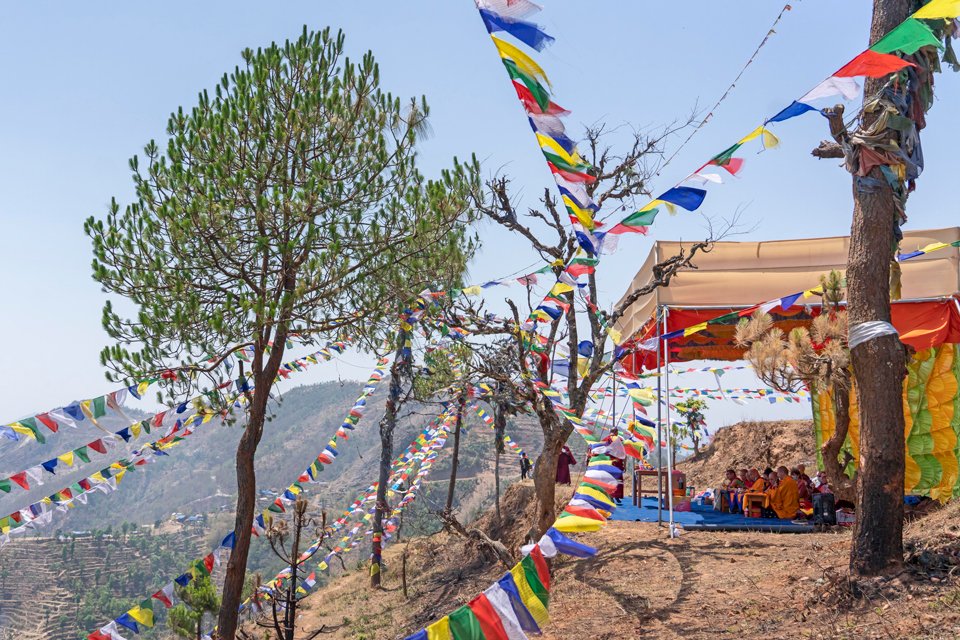
Lama Zopa Rinpoche and Khadro-la doing the bhumi puja on the ground where a 66-foot tall Padmasambhava statue will be built, Maratika, Nepal, April 2021. Photo by Ven. Lobsang Sherab.
In April 2021, Rinpoche and Khadro-la traveled to Maratika to see the land and do a preliminary blessing. In September 2021, Rinpoche returned to Maratika along with the Kopan lama gyupas and nuns to do the actual blessing of the land on the most auspicious day. This was meant to be just a short trip of two days, but since all the conditions for our visit were so idyllic—a smooth journey, perfect weather, peaceful and conducive accommodation—the trip was extended a further two days. This gave time for Rinpoche to interact with some of the local people. He taught two of the hotel owners, blessed the goats in Maratika liberated for his long life, gave two Zoom teachings, and also visited the main cave to make special prayers at the long life vase, which was opened only for Rinpoche. For those of us fortunate to accompany Rinpoche on the trip, it felt like a very auspicious time.
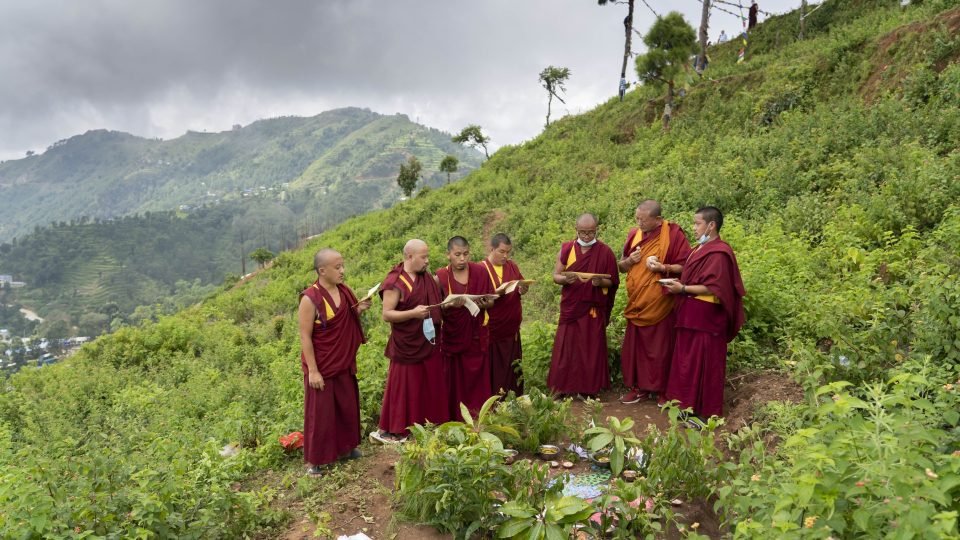
Kopan lama gyupas performing the bumi puja and ground consecration puja on the Guru Rinpoche statue land in Maratika, before the actual building begins of the statue, September 2021. Photo by Ven. Lobsang Sherab.
For pilgrims wishing to visit, Rinpoche translated The Requesting Prayer to Maratika, which is a concise guide to the holy places and holy objects of Maratika in the form of a prayer.[4]
I hope that everyone who reads this article will rejoice and aspire to visit Maratika and pray for the long lives of our precious teachers, the success of this holy object project, and for all our teachers wishes to be effortlessly fulfilled.
Ven Sarah Thresher is an English nun, currently living in Nepal. She first met Buddhism at Kopan in 1982 and ordained a few years later. In the past she has worked as an editor and taught at FPMT centers around the world.
Learn more about Rinpoche’s Vast Vision to build Padmasambhava statues around the world as part of the Padmasambhava Project for Peace.
Endnotes:
[1] Taken from The Vajra Song Melodiously Praising Maratika by Kyabje Trulshik Rinpoche.
[2] Good introduction to the sites of Maratika can be found on the websites Nekhor.org and Maratika.info.
[3] More information on this relationship past and present can be found in the book The Lawudo Lama.
[4] The prayer was composed by a Nyingma Khenpo while in retreat in Maratika and offered to Rinpoche in the cave while Rinpoche was doing practice.
- Home
- News/Media
- Study & Practice
- About FPMT Education Services
- Latest News
- Programs
- New to Buddhism?
- Buddhist Mind Science: Activating Your Potential
- Heart Advice for Death and Dying
- Discovering Buddhism
- Living in the Path
- Exploring Buddhism
- FPMT Basic Program
- FPMT Masters Program
- FPMT In-Depth Meditation Training
- Maitripa College
- Lotsawa Rinchen Zangpo Translator Program
- Universal Education for Compassion & Wisdom
- Online Learning Center
- Prayers & Practice Materials
- Overview of Prayers & Practices
- Full Catalogue of Prayers & Practice Materials
- Explore Popular Topics
- Benefiting Animals
- Chenrezig Resources
- Death & Dying Resources
- Lama Chopa (Guru Puja)
- Lama Zopa Rinpoche: Compendium of Precious Instructions
- Lama Zopa Rinpoche: Life Practice Advice
- Lama Zopa Rinpoche Practice Series
- Lamrim Resources
- Mantras
- Prayer Book Updates
- Purification Practices
- Sutras
- Thought Transformation (Lojong)
- Audio Materials
- Dharma Dates – Tibetan Calendar
- Translation Services
- Publishing Services
- Teachings and Advice
- Find Teachings and Advice
- Lama Zopa Rinpoche Advice Page
- Lama Zopa Rinpoche: Compendium of Precious Instructions
- Lama Zopa Rinpoche Video Teachings
- ༧སྐྱབས་རྗེ་བཟོད་པ་རིན་པོ་ཆེ་མཆོག་ནས་སྩལ་བའི་བཀའ་སློབ་བརྙན་འཕྲིན།
- Podcasts
- Lama Yeshe Wisdom Archive
- Buddhism FAQ
- Dharma for Young People
- Resources on Holy Objects
- Ways to Offer Support
- Centers
- Affiliates Area
- Teachers
- Projects
- Charitable Projects
- Make a Donation
- Applying for Grants
- News about Projects
- Other Projects within FPMT
- Support International Office
- Projects Photo Galleries
- Give Where Most Needed
- FPMT
- Shop
Translate*
*powered by Google TranslateTranslation of pages on fpmt.org is performed by Google Translate, a third party service which FPMT has no control over. The service provides automated computer translations that are only an approximation of the websites' original content. The translations should not be considered exact and only used as a rough guide.The sun of real happiness shines in your life when you start to cherish others.







